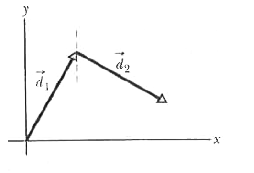A parallelogram is fromed with→a and →b as the sides let →d1 and →d2 be the diagonals of the parallelogram , them a2+b2=
A2+B2
A2−B22
A2+B22
2(A2+B2)
The correct Answer is:D
D21=A2+B2+2ABcosθ
D22=A2+B2−2ABcosθ
Topper's Solved these Questions
- VECTORSBOOK - GRB PUBLICATIONCHAPTER - VECTORSEXERCISE - MORE THAN ONE CHOICE IS CORRECT
15 Videos
- VECTORSBOOK - GRB PUBLICATIONCHAPTER - VECTORSEXERCISE - ASSERTION- REASON
1 Videos
- VECTORSBOOK - GRB PUBLICATIONCHAPTER - VECTORSEXERCISE - PROBLEMS FOR PARCTICE
23 Videos
- UNITS AND DIMENSIONSBOOK - GRB PUBLICATIONCHAPTER - UNITS AND DIMENSIONSEXERCISE - Link Compression
6 Videos
Similar Questions
If the area of the parallelogram with →a and →b as two adjacent sides is 15 sq unit ,than the area of the parallelogram having, 3→a+2→b and →a+3→b as two adjacent sides in sq unit is
View SolutionShow that area of the parallelogram whose diagonals are given by →a and →b is ∣∣→a×→b∣∣2. Also, find the area of the parallelogram, whose diagonals are 2ˆi−ˆj+ˆk and ˆi+3ˆj−ˆk.
View Solution
Knowledge Check
What is the geometric interpretation of the identity (→a−→b)×(→a+→b)=2(→a×→b)?
1. If the diagonals of a given parallelogram are used as sides of a second parallelogram, then the area of the second parallelogram is twice that of the given parallelogram.
2. If the semi-diagonals of a given parallelogram are used as sides of a second parallelogram, then the area of the second parallelogram is half that of the given parallelogram.
Select the correct answer using the code given belowA1 onlyB2 onlyCBoth 1 and 2DNeither 1 nor 2Diagonals of a parallelogram are respresented by vectors →A=5ˆi−4ˆj+3ˆkand→B=3ˆi+2ˆj−ˆk. Area of the parallelogram is :
A√171unitsB√72unitsC√72unitsD72 unitsStatement 1 : If ∣∣→a+→b∣∣=∣∣→a−→b∣∣, then →aand→b are perpendicular to each other.
Statement 2 : If the diagonals of a parallelogram are equal in magnitude, then the parallelogram is a rectangle.ABoth the statements are true, and Statement 2 is the correct explanation for Statement 1.BBoth the statements are true, but Statement 2 is not the correct explanation for Statement 1.CStatement 1 is true and Statement 2 is false.DStatement 1 is false and Statement 2 is true.
Vectors along the adjacent sides of parallelogram are →a=ˆi+2ˆj+ˆkand→b=2ˆi+4ˆj+ˆk. Find the length of the longer diagonal of the parallelogram.
View Solution(a) In the figure here, what are the signs of the x components of →d1and→d2 ? (b) What are the signs of the y components of →d1and→d2 ? (c ) What are the signs of the x and y components of →d1+→d2 ?

View SolutionA parallelogram is constructed on 3→a+→band→a−4→b,where|→a|=6and∣∣→b∣∣=8 and →aand→b are anti parallel then the length of the longer diagonal is (A) 40 (B) 64 (C) 32 (D) 48
View SolutionABCD is parallelogram →A,→B,→Cand→D are the position vectors of vecticles A, B, C, and D with respect to any origin, them:
View SolutionIf (→a×v→b)×(→c×→d).(→a×→d)=0 then which of the following may be true ?
View Solution
